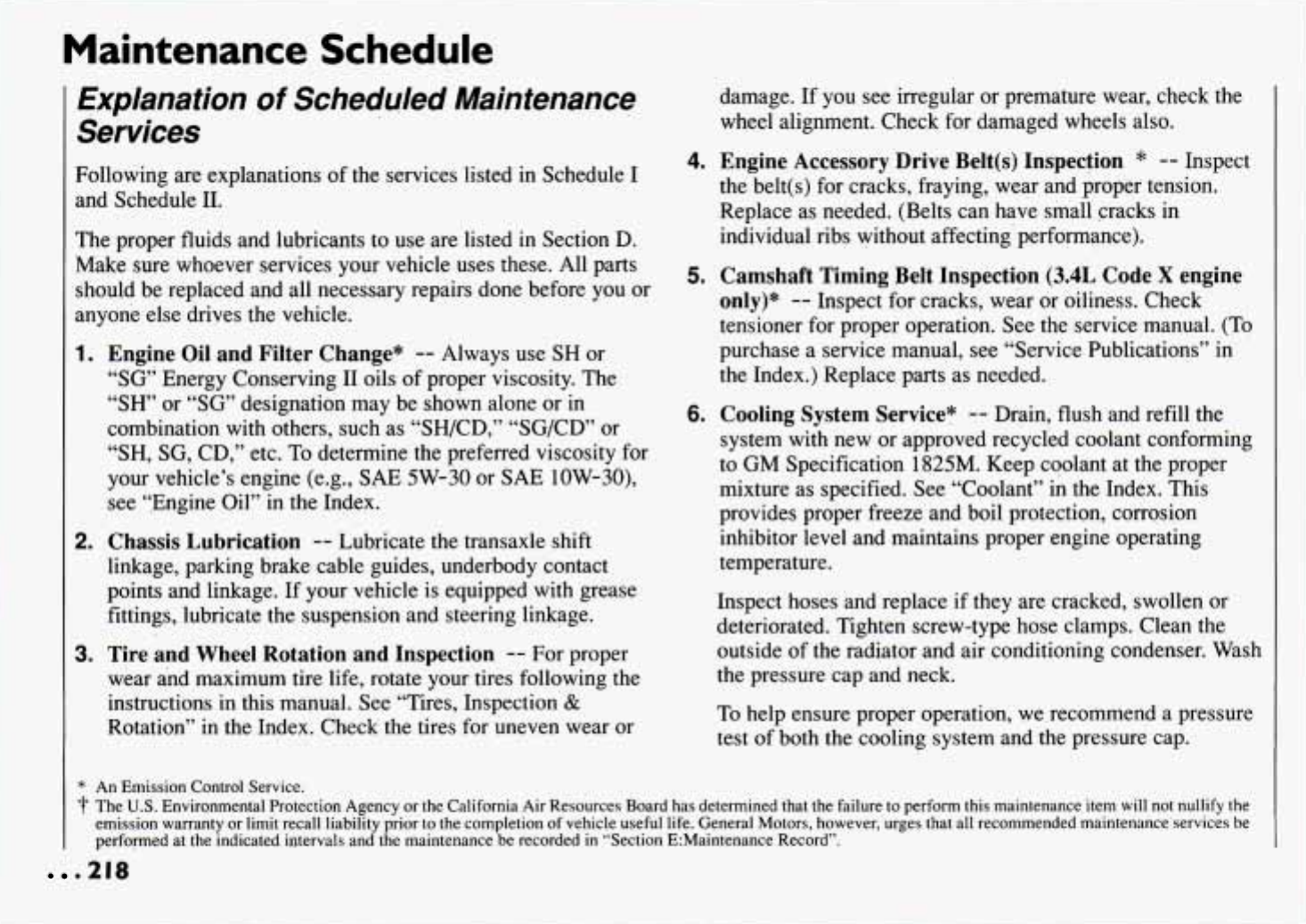
Maintenance Schedule
Explanation
of
Scheduled Maintenance
Services
Following are explanations of the services listed
in
Schedule I
and Schedule
11.
The proper fluids and lubricants to use are listed in Section D.
Make sure whoever services your vehicle uses these. All parts
should be replaced and all necessary repairs done before you or
anyone else drives the vehicle.
1.
Engine
Oil
and Filter Change*
--
Always use
SH
or
“SG”
Energy Conserving I1 oils of proper viscosity. The
“SH”
or
“SG”
designation may be shown alone or
in
combination
with
others, such as “SH/CD,” “SG/CD” or
“SH,
SG, CD,” etc.
To
determine the preferred viscosity for
your vehicle’s engine (e.g., SAE 5W-30 or SAE 10W-30),
see “,Engine Oil” in the Index.
2.
Chassis Lubrication
--
Lubricate the transaxle shift
linkage, parking brake cable guides, underbody contact
points and linkage. If your vehicle is equipped
with
grease
fittings, lubricate the suspension and steering linkage.
3.
Tire and Wheel Rotation and Inspection
--
For proper
wear and maximum tire life, rotate your tires following the
instructions in this manual. See “Tires, Inspection
&
Rotation”
in
the Index. Check the tires for uneven wear or
*
An Emission Control Service.
4.
5.
6.
damage. If you see irregular or premature wear, check the
wheel alignment. Check for damaged wheels also.
Engine Accessory Drive Belt(s) Inspection
*
--
Inspect
the belt(s) for cracks, fraying, wear and proper tension.
Replace as needed. (Belts can have small cracks in
individual ribs without affecting. performance).
Camshaft Timing Belt Inspection (3.4L Code
X
engine
only)*
--
Inspect for cracks, wear or oiliness. Check
tensioner for proper operation. See the service manual. (To
purchase a service manual, see “Service Publications”
in
the Index.) Replace parts as needed.
Cooling System Service*
--
Drain,
flush
and refill the
system with new or approved recycled coolant conforming
to
GM
Specification 1825M. Keep coolant at the proper
mixture as specified. See “Coolant” in the Index. This
provides proper freeze and boil protection, corrosion
inhibitor level and maintains proper engine operating
temperature.
Inspect hoses and replace
if
they are cracked, swollen or
deteriorated. Tighten screw-type hose clamps. Clean the
outside of
the
radiator and air conditioning condenser. Wash
the pressure cap and neck.
I
To
help ensure proper operation,
we
recommend a pressure
test of both the cooling system and the pressure cap.
The
U.S.
Environmental Protection Agency
or
the California Air Resources Board has determined that the failure
to
perform this maintenance item will not nullify the
emission warranty
or
limit recall liability prior to the completion
of
vehicle useful life. General Motors, however, urges that all recommended maintenance services be
perfoped at the indicated intervals and the maintenance be recorded
in
“Section E:Maintenance Record”.
218


















